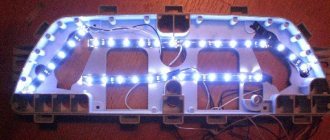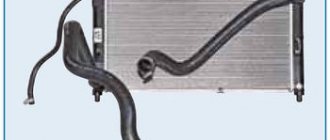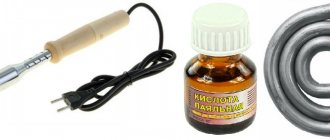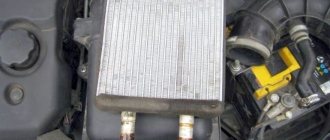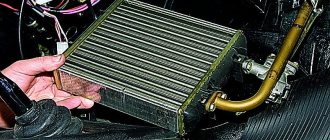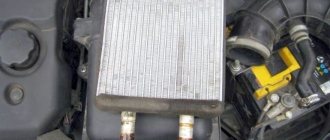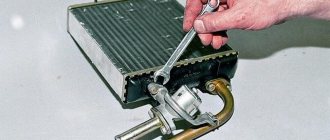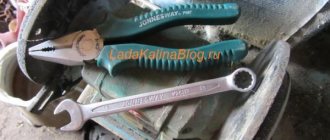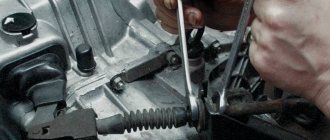Let's say a car owner, for some reason, decides that the engine radiator needs to be replaced. Usually, this happens after unsuccessful flushing of the cooling system, after an accident, and so on. In Kalina-2, you can replace the radiator without even disassembling the unit called the “bumper”.
That is, the protective mesh (grid) will remain in place. Next we look at what exactly needs to be dismantled before removing the radiator. Note that this unit itself is attached to the body with two M6 nuts. Confirmation is in the standard drawings.
Diagrams of the radiator assembly and its fasteners
When to change the radiator
Regardless of location, design and intended purpose, radiators should be replaced when a leak is detected. Some types of coolers can be repaired. At the same time, specialists plug the damaged areas, which makes it possible to continue to operate the device. The disadvantage of the restoration procedure is a noticeable decrease in the efficiency of the part. The machine overheats faster and does not maintain operating temperature well.
Cases of decreased trafficability of highways are considered separately. When using low-quality antifreeze, sediment and scale may form. When sludge completely clogs the tubes, the part must be decarbonized or replaced.
Basic radiator malfunctions
Malfunctions of this Kalina unit do not occur so often and are the result of wear and tear due to natural causes of the car owner’s negligence. There are two most common types of problems:
Leaks are dangerous because a decrease in coolant level leads to an increase in engine temperature. This leads to overheating and jamming of the motor. A leak of hot antifreeze can be dangerous. The fluid in the system is under pressure, a leak can form a fountain, and contact of hot antifreeze on exposed skin will cause burns.
Coking disrupts the antifreeze circulation process. As a result, the lower part of the radiator begins to cool, and then the entire heat exchanger. The liquid will not cool, causing the engine to overheat. In most cases, the cause of coking is ordinary scale. This happens when tap water is poured into the SOD. Less commonly, blockages occur due to mixing oil and antifreeze. In this case, the reason is the loss of tightness of the cylinder head gasket.
At an early stage, coking is difficult to detect. In advanced cases, mixing oil and antifreeze forms a consistency similar to jelly, which makes the heat exchanger tubes difficult to pass or completely impassable.
Replacing the radiator Lada Kalina 1st generation
The repair procedure is as follows.
- Prepare the required materials: a Phillips screwdriver, 10-mm sockets and open-end wrenches, a container for draining the waste,
- The car is thoroughly washed and left in the inspection pit to cool the power plant. When performing repairs, care must be taken - even small debris should not enter the cooling system.
- After the car has cooled, drain the waste into a previously prepared canister. Initially, the cover of the radiator and radiator opens, then the drain opens and the liquid flows on its own to where it is directed.
- Loosen the clamp securing the upper pipe and remove it. The lower hose is unscrewed in the same way.
- Next, you will need to release the seal of the expansion tank and radiator. Using pliers, loosen the plastic clamp and pull the thin hose off the tube flange.
- The next step is to remove the radiator itself. Using wrench No. 10, unscrew the two screws securing the part to the car body.
- Tilt the radiator approximately 10-15 cm towards the engine and pull it up. After this, the part should easily separate from the machine.
- If plastic fasteners are stuck at the bottom of the device, they need to be removed and moved to the body brackets.
When installing it back, there is no need to replace the lower cross member of the Lada Kalina radiator frame - the part is put back in place in the reverse order. But for convenience, the operation can be performed.
Fundamentally, replacing the radiator of a 2nd generation Lada Kalina is practically no different from the procedure performed on a car of the first modification. The main difference is only the need to first remove the plastic engine cover.
How to eliminate airiness
When the radiator is removed and there is no coolant, the Kalina's cooling system can be modified. The fact is that in the VAZ-1118 it suffers from one unpleasant “disease” - airing and overheating, which is associated with a mistake by the car’s developers. Methods by which modernization is usually carried out:
- Replacing the thermostat. Instead of the standard one, which has 5 holes, a new element with 6 holes is installed.
- A coolant filter is added to the design.
- A faucet is installed on the Kalina stove.
The methods listed are not very effective, so experienced car enthusiasts use a more radical modification of the cooling system with the addition of a steam exhaust tube.
The scheme is as follows: a tee is cut into the pipe going to the expansion tank, which is connected with a separate hose to the fitting on the throttle valve block. The second tee is placed on the return line from the stove and is also connected to the expansion tank.
The procedure for replacing an engine cooling radiator is not particularly difficult and, if you have time, can be easily done with your own hands. What you cannot do yourself is to solder the aluminum honeycombs of the unit, and not every service station will undertake this.
tweet
back Selecting covers for Kalina
Next How to adjust the clutch on Kalina yourself
Tags: replacement, radiator, repair
Replacing a heating system radiator
The planned replacement of the stove radiator on the Lada Kalina is carried out as follows.
- Allow the car to cool and drain the antifreeze from the cooling system. To do this, unscrew the plugs of the head radiator and expansion tank. Next, remove the drain plug and allow the liquid to drain into a pre-positioned container.
- Disconnect the transmission rods from the module itself.
- Having moved into the car interior, it is recommended to remove the front seats - this is not necessary, but will increase the ease of repair.
- Next, remove the gearshift lever along with the panel and drive. Also remove the fasteners.
- The next step is to remove the center console trim using a Phillips screwdriver.
- Next comes the removal of the gear lever housing.
- Remove the opened radiator from the pipes and fasteners and remove it from the car.
- Reassembling the unit is performed in reverse order.
How to remove the air conditioner radiator on Kalina
Kalina 1 and Kalina 2 cars use a liquid cooling system. It consists of an engine jacket, radiator, electric fan, pump (water pump), expansion tank, thermostat and connecting hoses. The coolant moves through two circulation circuits. In a small circle, antifreeze circulates only through the engine jacket, while in a large circle, the liquid passes through the radiator.
Expansion tank
Used to pour liquid into the system. It is made of heat-resistant plastic of a translucent color to allow you to control the level of antifreeze. There is a special pipe on the top through which the tank is connected to the radiator steam outlet.
The tightness of the entire system is ensured by the valve cover, which has inlet and outlet valves. The latter is designed to maintain pressure in the SOD above atmospheric pressure. Due to this, losses in the form of steam are reduced, and the boiling point of the working fluid increases. The exhaust valve of the cover opens when the pressure rises to 1.1 bar, and the inlet valve opens when the pressure drops to 0.13 bar and the engine cools down.
water pump
This is a centrifugal pump with blades. It is belt driven from a crankshaft pulley and is included in the gas distribution system. The pump is made of aluminum. This unit cannot be repaired; if it fails, it can only be replaced. Rotation occurs due to a double-row non-separable bearing; its high-temperature lubricant is designed for the entire service life. There is a toothed pulley at the front and an impeller at the rear.
Thermostat
Designed to redistribute coolant flows, it contains a temperature-sensitive element and two valves. When the engine cools down, one of the thermostat valves is in the closed position, and fluid circulates through the motor jacket - only a small circuit is used. As the temperature reaches 85 degrees, the second valve begins to open slightly, allowing antifreeze into the radiator and closing the bypass channel. Full opening occurs at a temperature of 100 degrees. In this case, all the liquid begins to pass through the cooler.
Engine radiator
The heat exchanger can be monolithic aluminum, tubular, or plate type. Its device uses two plastic tanks that are connected by tubes. The upper one is inlet, and the lower one is outlet, through which the cooled liquid is sent back to the engine. Near the first there is a steam outlet connected to the expansion tank. The radiator on Kalina is complemented by an electric fan. There is a drain plug at the bottom of the outlet tank.
An electric fan cools the liquid forcibly. It is turned on via a relay after a command from the ECU when the temperature reaches critical levels.
The cooling system is complemented by a heater radiator, which is integrated into the ODS and is used to heat the air in the cabin, since hot antifreeze also passes through it. The controller monitors the coolant temperature using a sensor that is installed in the cylinder head and transmits readings to the instrument panel. To transmit a signal to the controller, a sensor installed on the exhaust pipe, near the thermostat, is used.
Replacing the radiator insert on models with air conditioning
Replacing the air conditioner radiator on Lada Kalina
The sequence of actions is as follows
- Remove the car bumper.
- Pour the antifreeze into a container prepared in advance.
- Disconnect the radiator fan terminals.
- Remove the pressure pipes and plug them to prevent dirt from entering.
- Press out the plastic fasteners of the cooling system and remove the air conditioner radiator from the car.
Installation of a new element is carried out in the reverse order.
If it is necessary to install a new element, the plastic line plugs are removed only immediately before installing it on the machine.
Causes of breakdowns in the cooling system
Replacing the cooling radiator on Kalina can only be done in emergency cases when the breakdown is caused by mechanical damage from outside. In other cases, they try to eliminate the leak by replacing pipes or clamps.
The main causes of circulation system malfunctions:
- A defective clamp and rupture of the pipe resulting in a leak of antifreeze or antifreeze;
Radiator diagnostics can be carried out in two ways:
- On your own in the garage;
- With the involvement of qualified specialists at a service station.
Alternative methods for removing the stove
It is quite natural that the procedures described in the manual, which sometimes stretch over an unacceptably long period of time, spurred the imagination of car enthusiasts who invented their own, simpler, but often less accurate methods of dismantling the heater radiator. Through trial and error, a relatively acceptable alternative was found.
Differences between modifications with air conditioning
Some configurations of the Lada Kalina are complemented by air conditioning, which is part of the climate control system and is used to cool the air in the cabin. The device cannot operate if the outside temperature is below 5 degrees, the engine is not running, or the heater fan is on. The air conditioning compressor is driven by the engine, and this is the main disadvantage of the installation.
The use of a cooler increases fuel consumption and negatively affects dynamic performance. The temperature is adjusted using the knob on the climate control unit in the cabin. In a car with air conditioning, the air flows first to the evaporator and then to the heater core.
Option two: replacement with complete disassembly of the dashboard
Following the instructions given on how to remove the old radiator, you must repeat the first four steps of the work described above (with the exception of dismantling the gas pedal and steering column). Next we perform the following steps:
- We completely remove the decorative trims of the instrument panel, remove the radio and climate control control unit from the center console.
- We dismantle all the air ducts and the trim in front of the windshield, which will provide access to the nine bolts that secure the dashboard. Unscrew the bolts and dismantle the panel.
- We remove the entire stove casing by unscrewing its fasteners (from the side stiffeners of the body). We remove the old stove and install a new one.
- We return all the removed elements to their place (in reverse order).
New Lada: Generator on Granta in Balashikha, p. 2
Preparatory process with preliminary disassembly
To ensure the ability to carry out repair work to replace the radiator, you will need to acquire the following tools:
- locksmith set, which includes a wide range of standard keys;
- a hacksaw for metal with the ability to extend the blade;
- a container paired with a hose to drain antifreeze;
- silicone sealant or other means for gluing plastic;
- with a rag.
During the procedure for replacing the heater in the LADA Kalina model, we also recommend replacing its power supply and return pipes. On old hoses there is a high probability of cracks appearing, which can manifest themselves unexpectedly and negatively. This approach will eliminate the need to repeat the labor-intensive disassembly procedure in order to replace the pipes
We advise you to pay attention to silicone products
An important step is removing the knot
The cooling radiator and related components are unscrewed using the following tools:
- socket wrench 10;
- pliers with cylindrical thin ends;
- Phillips screwdriver;
- when carrying out work on Kalina with air conditioning, use a set of TOPEX internal socket wrenches (star-shaped).
To dismantle the radiator, you must first remove the engine cooling fan, having first disconnected the power connector from it. The fan is attached to the radiator with 4 bolts. The bolts are unscrewed with a 10 mm socket wrench, after which the fan is removed through the top.
The next step is to remove the rubber pipes from the radiator: upper, lower and coming from the expansion tank. The pipe clamps are loosened using pliers or a screwdriver. Next, use the same key to unscrew the 2 nuts securing the unit. The cooler can now be tilted towards the engine and pulled out.
When working with an air conditioned Kalina, you will have to deal with an additional cooling device attached to the main radiator. To separate them, you need to unscrew 4 bolts with a star key.
When removing the radiator, pay attention to the lower support pads; they can be removed along with the unit or remain in the body holes. It is better to remove the pillows to examine them for functionality. The same applies to rubber-metal bushings installed on the cooler body. If necessary, these parts must also be replaced.
A radiator malfunction can be localized by plugging its large pipes, immersing it in a container of water and supplying air at a pressure of no higher than 1 bar through a small fitting. If there are many places where air breaks through, then the unit is replaced with a new one.
If you have 1-2 small fistulas, try to negotiate a repair at a service station; you should not undertake this yourself. The design of the aluminum radiator is such that careless movements can easily cause even more damage.
Selection of spare parts
The choice of a stove radiator should be approached carefully, since changing it is quite inconvenient. The majority of motorists choose an original part that is available for sale. But few people know that there are several analogues.
Let's consider the heater radiator options for Kalina, their catalog numbers:
- 1118-8101060 is the article number of the original catalog number of the heater radiator for Kalina. It fits perfectly and does not require any modifications. Average
Features and nuances of the heater design
Note that problems during replacement are caused not by dismantling, but by installing a new radiator. There are two main nuances that make it difficult to fit the heat exchanger into the heater housing. The first one is the installation side. The radiator is pulled out towards the pedal block, and the pedals themselves prevent the radiator from “coming out”. But this does not cause problems during dismantling, since the leaking heat exchanger can be sawed and removed. But it’s impossible to install a new radiator because of the pedals.
The second nuance is the design of the radiator itself. The heat exchanger fittings for connecting the cooling system pipelines are long and pass through the engine shield. Thanks to this, the connection of the pipes with the radiator is carried out in the engine compartment and if the fastening clamps are loosened, the antifreeze flowing through the leak does not enter the passenger compartment. But due to the long fittings, you can only pull out the heater radiator by moving the heater housing toward the passenger compartment, and this is only possible with the front panel removed.
The replacement methods that car enthusiasts have come up with involve some modifications to the heater elements, allowing the installation of a heater radiator. In the future, these modifications make it possible to replace the heat exchanger without problems and in a short time.
